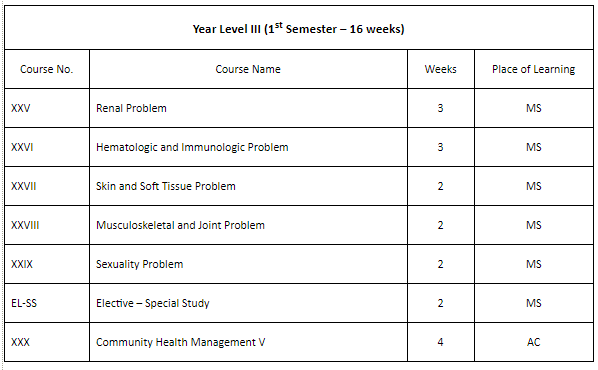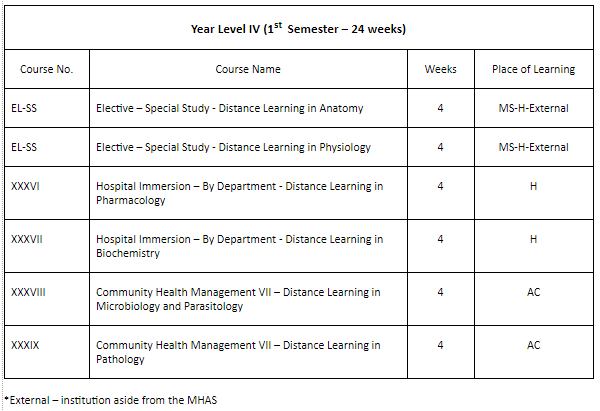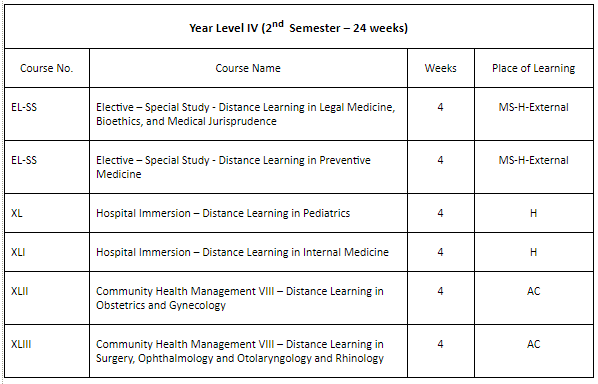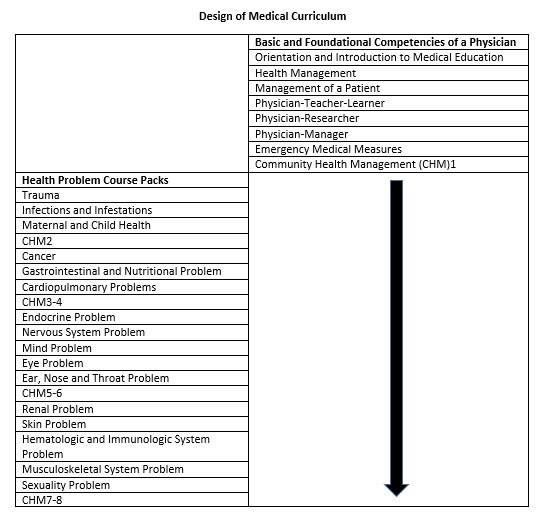Name of Medical School
The name shall be ROJoson Medical and Health Administration School (ROJMHAS).[hypothetical school]
LIST AND SCHEDULE OF COURSES








ROJ@21jan13

Name of Medical School
The name shall be ROJoson Medical and Health Administration School (ROJMHAS). [hypothetical school]
CURRICULAR SCHEDULE AND PLACES OF LEARNING

Legend:
MS – Medical School
AC – An assigned community in the city and nearby provinces
H – Hospital
EL-SS – Elective-Special Study
ROJ@21jan13
Name of Medical School
The name shall be ROJoson Medical and Health Administration School (ROJMHAS). [hypothetical school]
Curriculum Map
The curriculum map contains the program outcomes (1-10) and the different courses per year level according to the degree of breadth and depth that these courses contribute to achieving the program outcomes.
Degree of emphasis: HOW PROGRAM OUTCOMES AND COURSES ARE TO BE COVERED
I–introduced – basic concepts are merely introduced (program outcomes are merely introduced in the course)
P–practiced – the concepts & principles are presented with applications (program outcomes are not just introduced but practiced in the course)
D–demonstrated – I + P + with skills acquisition (program outcomes are practiced and demonstrated)
Program Outcomes (as required by CHED together with those listed under Instructional Objectives):
1-Demonstrate clinical competence
2-Communicate effectively
3-Lead and manage health care teams
4-Engage in research activities
5-Collaborate with interprofessional teams
6-Utilize systems-based approach to healthcare
7-Engage in continuing personal and professional development
8-Adhere to ethical, professional and legal standards
9-Demonstrate nationalism, internationalism and dedication to service
10-Practice the principles of social accountability
Curriculum Map of ROJMHAS
Year Level I – 1st Semester – all 10 program outcomes are introduced and practiced.
Year Level I – 2nd Semester up to Year Level IV -2nd Semester – all 10 program outcomes are practiced and demonstrated.
ROJ@21jan13
Name of Medical School
The name shall be ROJoson Medical and Health Administration School (ROJMHAS). [hypothetical school]
EVALUATION
PRACTICAL EXAMINATION
ORAL EXAMINATION
WRITTEN EXAMINATION
OUTCOME OF TASKS/PROJECTS
The minimum requirements for evaluation of students of CHED will be conformed to.
ROJ@21jan13
Name of Medical School
The name shall be ROJoson Medical and Health Administration School (ROJMHAS). [hypothetical school]
LEARNING STRATEGIES/APPROACHES/ACTIVITIES/RESOURCES
ACTIVE LEARNING ACTIVITIES
SELF-DIRECTED LEARNING ACTIVITIES
Outcome-based learning
Competency-based learning
Community-based learning
Problem-based learning
Group discussions
Lecturettes
Independent studies
Demonstration and return demonstration
Simulated learning
Actual/direct patient contact/learning
Actual/direct community contact/learning
Tasks/projects
Hand-outs
Self-instructional programs
LEARNING RESOURCES
CHED’s minimum requirements for learning resources will be conformed to.
QUALIFICATIONS AND TRAININGs OF DEAN AND FACULTY
CHED’s minimum requirements for qualifications and trainings of the dean and faculty will be conformed to.
A Medical Education Unit shall be established.
ROJ@21jan13
Name of Medical School
The name shall be ROJoson Medical and Health Administration School (ROJMHAS). [hypothetical school]
CONTENTS
* Determined by the instructional objectives.
* Determined by CHED minimum requirements on curricular contents
* SEE LIST OF COURSES AND MODULES (NOTE: contents based instructional objectives and CHED minimum requirements on curricular contents will be integrated into the courses and modules.)
| PHYSICIAN-COMPETENCIES COURSES | |
| ORIENTATION AND INTRODUCTION | |
| HEALTH MANAGEMENT | |
| MANAGEMENT OF A PATIENT | |
| PHYSICIAN-TEACHER-LEARNER | |
| PHYSICIAN-RESEARCHER | |
| PHYSICIAN-MANAGER | |
| EMERGENCY MEDICAL MEASURES | |
| COMMUNITY HEALTH MGT I | |
| HEALTH PROBLEM COURSES | |
| TRAUMA | |
| INFECTIONS AND INFESTATIONS | |
| MATERNAL AND CHILD HEALTH PROBLEMS | |
| CANCER | |
| GASTROINTESTINAL AND NUTRITIONAL PROBLEMS | |
| CARDIOPULMONARY PROBLEMS | |
| ENDOCRINE PROBLEMS | |
| NERVOUS SYSTEM PROBLEMS | |
| MIND PROBLEMS | |
| EYE PROBLEMS | |
| EAR, NOSE, AND THROAT PROBLEMS | |
| RENAL PROBLEMS | |
| SKIN AND SOFT TISSUE PROBLEMS | |
| HEMATOLOGIC AND IMMUNOLOGIC PROBLEMS | |
| MUSCULOSKELETAL AND JOINT PROBLEMS | |
| SEXUALITY PROBLEMS | |
| COMMUNITY HEALTH MANAGEMENT COURSES II –VIII | |
| ELECTIVE – SPECIAL STUDY |


CHED Minimum Curricular Contents Requirements
Human Anatomy including Gross, Microscopic and Developmental Anatomy
Human Physiology
Biochemistry, Molecular Biology, Genetics and Basic Nutrition
Pharmacology and Therapeutics including Alternative Medicine
Microbiology, Parasitology and Immunology
Internal Medicine including Geriatrics and Dermatology
General and Clinical Pathology and Oncology
Obstetrics and Gynecology including Women’s Health
Pediatrics and Nutrition including child protection
General Surgery and its divisions including Anesthesiology and Pain Management
Orthopedics
Otorhinolaryngology
Ophthalmology
Psychiatry and Behavioral Sciences
Basic and Clinical Neurosciences
Family and Community Medicine including Public Health and Preventive Medicine and Health Economics
Physical and Rehabilitation Medicine
History and Perspectives in Medicine
Research, Evidence-based Medicine and Medical Informatics
Legal Medicine, Medical Jurisprudence and Forensic Medicine
Radiology and other diagnostic imaging
CHED Minimum Integrated Topics
Bioethics, Professionalism and Good Clinical Practice
Consultation Skills, Physical Diagnosis
Andragogy
Disaster Risk Reduction and Management
Leadership and Management
Interprofessional Education
ROJ@21jan13
Name of Medical School
The name shall be ROJoson Medical and Health Administration School (ROJMHAS). [hypothetical school]
INSTRUCTIONAL OBJECTIVES (ROJMHAS)
At the end of a 4-year course, the graduate should be able to:
(dual degree course shall be discussed separately)
COGNITIVE
1. Solve the health problems of the city and nearby provinces.
2. Pass the Philippine Board of Medicine examination.
3. Diagnose in an effective, efficient, and humane manner the health problems of a patient and a community.
4. Conduct diagnostic procedures in an effective, efficient, and humane manner in the investigations of a patient and a community.
5. Treat effectively, efficiently, and humanely the health problems of a patient and a community.
6. Educate properly patients and the community regarding recognition, causation, treatment, prevention, and rehabilitation of diseases and health problems.
7. Conduct health researches.
8. Manage effectively and efficiently a health care unit and health care programs.
9. Teach effective, efficient, and humane medicine to future medical students.
10. Do proper medical recording.
CHED 1-Demonstrate clinical competence = Competently manage clinical conditions of all patients in various settings.
CHED 3-Lead and manage health care teams = Initiate planning, organizing, implementation and evaluation of programs and health facilities. Provide clear direction, inspiration and motivation to the healthcare team / community.
CHED 4- Engage in research activities = Utilize current research evidence in decision making as practitioner, educator or researcher. Participate in research activities.
CHED 5- Collaborate with interprofessional teams = Effectively work in teams in managing patients, institutions, projects and similar situations.
CHED 6-Utilize systems-based approach in healthcare = Utilize systems-based approach in actual delivery of care. Network with relevant partners in solving general health problems.
PSYCHOMOTOR
1. Perform gentle, safe, and accurate physical examinations of patients.
2. Perform accurately basic life support procedures.
3. Perform properly invasive diagnostic procedures.
4. Perform properly life-saving surgical procedures.
5. Administer parenteral medications.
6. Write proper and legible prescriptions.
7. Perform properly an obstetrical vaginal delivery.
8. Communicate properly with patients, community leaders, and colleagues.
9. Present properly in medical conferences.
10. Construct proper audio-visual aids.
CHED 2-Communicate effectively = Convey information in written and oral formats, across all types of audiences, venues, and media in a manner that can be easily understood.
AFFECTIVE
1. Assume responsibility for the solution of the health problems in a community where he/she resides or is assigned to.
2. Initiate projects that will help solve the health problems in the community where he/she resides.
3. Utilize effectively and efficiently whatever scarce resources that are available to solve the health problems of the community.
4. Utilize primary health care approaches in the solution of the health problems in the community.
5. Accept his/her limitations in the practice of the medical profession.
6. Continually strive for excellence in medical education, research, and service.
7. Set example of an effective, efficient, and humane physician; a physician-administrator; a physician-researcher; and a physician-educator.
8. Show respect for human life and the human being (patient).
9. Show respect to colleagues in the medical profession.
10. Show respect to authority.
CHED 7-Engage in continuing personal and professional development = Update oneself through a variety of venues for personal and professional growth to ensure quality healthcare and patient safety.
CHED 8-Adhere to ethical, professional, and legal standards = Adhere to national and international codes of conduct and legal standards that govern the profession.
CHED 9-Demonstrate nationalism, internationalism and dedication to service = Demonstrate love of one’s national heritage, respect for other cultures and commitment to service.
CHED 10-Practice the principles of social accountability = Adhere to the principles of relevance, equity, quality and cost effectiveness in the delivery of healthcare to patients, families and communities.
ROJ@21jan13
Program Outcomes (What will a medical student be able to do after finishing an MD program – Required by CHED):
1-Demonstrate clinical competence
2-Communicate effectively
3-Lead and manage health care teams
4-Engage in research activities
5-Collaborate with interprofessional teams
6-Utilize systems-based approach to healthcare
7-Engage in continuing personal and professional development
8-Adhere to ethical, professional and legal standards
9-Demonstrate nationalism, internationalism and dedication to service
10-Practice the principles of social accountability
Program Outcomes with Operational Definitions (CHED)
1-Demonstrate clinical competence = Competently manage clinical conditions of all patients in various settings.
2-Communicate effectively = Convey information in written and oral formats, across all types of audiences, venues, and media in a manner that can be easily understood.
3- Lead and manage health care teams = Initiate planning, organizing, implementation and evaluation of programs and health facilities. Provide clear direction, inspiration and motivation to the healthcare team / community.
4- Engage in research activities = Utilize current research evidence in decision making as practitioner, educator or researcher. Participate in research activities.
5- Collaborate with interprofessional teams = Effectively work in teams in managing patients, institutions, projects and similar situations.
6-Utilize systems-based approach in healthcare = Utilize systems-based approach in actual delivery of care. Network with relevant partners in solving general health problems.
7-Engage in continuing personal and professional development = Update oneself through a variety of venues for personal and professional growth to ensure quality healthcare and patient safety.
8-Adhere to ethical, professional, and legal standards = Adhere to national and international codes of conduct and legal standards that govern the profession.
9-Demonstrate nationalism, internationalism and dedication to service = Demonstrate love of one’s national heritage, respect for other cultures and commitment to service.
10-Practice the principles of social accountability = Adhere to the principles of relevance, equity, quality and cost effectiveness in the delivery of healthcare to patients, families and communities.
* Will be adopted by ROJMHAS (ROJoson Medical and Health Administration School).
ROJ@21jan13
Name of Medical School
The name shall be ROJoson Medical and Health Administration School (ROJMHAS). [hypothetical school]
Philosophy of ROJMHAS
We, the Board of Trustees and Faculty of the ROJoson Medical and Health Administration School, believe that:
1. Man exists not only for himself but also for other people in the community.
2. Society exists for the welfare of men.
3. Health is a fundamental right of every person.
4. There will always be health problems in every person and in every community at one time or another.
5. The medical school exists because of the health problems that are prevalent in every person and in every community.
6. The medical school should help solve the health problems of the community through its administrators, faculty, students, and graduates and through a primary health care approach.
7. Medical students shall be treated as adult learners.
8. All adults are capable of learning given the proper guidance and support.
9. Active learning activities yield the best results.
10. Learning to become a competent physician is best achieved through an outcome-based, competency-based and problem-based learning approach.
11. Learning to be a community-oriented physician is best achieved through a community-based learning approach.
12. Medical education is a life-time learning process.
13. All physicians should have competency in self-directed learning.
Vision and Mission
We, the Board of Trustees and Faculty of the ROJoson Medical and Health Administration School, envision and aim to produce graduates who:
1. Will solve the health problems of the city and nearby provinces as a priority over other communities.
2. Will be able to solve the health problems of a community other than that of the city and nearby provinces.
3. Will be able to pass the Philippine Board of Medicine examination.
4. Are competent (effective, efficient, and humane) in the practice of their medical profession.
5. Are self-directed physicians in their continuing medical education.
6. Will be effective and efficient administrators of a health care unit and health care programs.
7. Will be able to conduct health researches.
8. Will be able to be medical teachers.
ROJ@20jan13
Name of Medical School
The name shall be ROJoson Medical and Health Administration School (ROJMHAS). [hypothetical school]
Guidelines in the Design of the Medical Curriculum of ROJMHAS
The medical curriculum of the ROJMHAS is designed according to the following general guidelines:
1. Philosophy-vision-mission of the ROJMHAS.
2. Outcome-based learning approach. Program outcomes consist of the following:
2.1.Primary or basic physician
2.2 Special elective skills (such as such as emergency medicine, health service / program administration, public health and health profession education)
2.3 Skills in solving a community health problem
2.4 Philippine Board of Medicine passer
3. Competency-based learning approach.
4. Community-based learning approach.
4.1 Each student will spend about 25% of the medical course in a community learning medicine and solving the health problems of the community.
4.2 Each student has an assigned community such as a barangay health station or a rural health unit in the city and nearby provinces as his/her laboratory for learning. He/She is exposed to his/her assigned community as early as his/her first year of medical schooling.
4.3 In his/her assigned community, under the guidance of a faculty, he/she will serve as a community physician who will manage the health problems of individuals.
4.4 In his/her assigned community, under the guidance of a faculty, he/she will serve as a community physician who will solve the health problems of the community. He/She is expected to solve at least one community health problem during his/her entire medical schooling. This is one of the major requirements for passing the course or for graduation.
5. Problem-based learning approach.
6. Distance education mode of teaching and learning especially when students are in the community away from the school.
7. The selection of contents will be on the basis of expected outcomes of graduates, importance (“must know”) and relevance to being a physician and to being a solver of the health problems of the community.
8. The organization of the content will be structured:
8.1 From general to specific.
8.2 From simple to complex.
8.3 From basic to advanced.
8.4 Based on prioritization of importance and relevance.
8.5 Based on rational sequence.
9. The overall design of the instruction is such that it starts from an overview, framework, progressing to foundation, development, and ending in mastery.
10. Integrated approach as early as the first year of medical schooling with no medical subspecialty departmentalization of subject matter and no separation of basic and clinical sciences.
11. Self-directed learning will be promoted through a problem-based learning approach, self-instructional programs, and independent study.
12. Emphasis on active learning activities such as group discussions, direct patient and community contacts, practicum, and projects as modes of teaching and learning.
13. Avoidance of lectures as a primary mode of teaching and learning.
14. Preparation of students for the Philippine Board of Medicine examination.
ROJ@21jan13